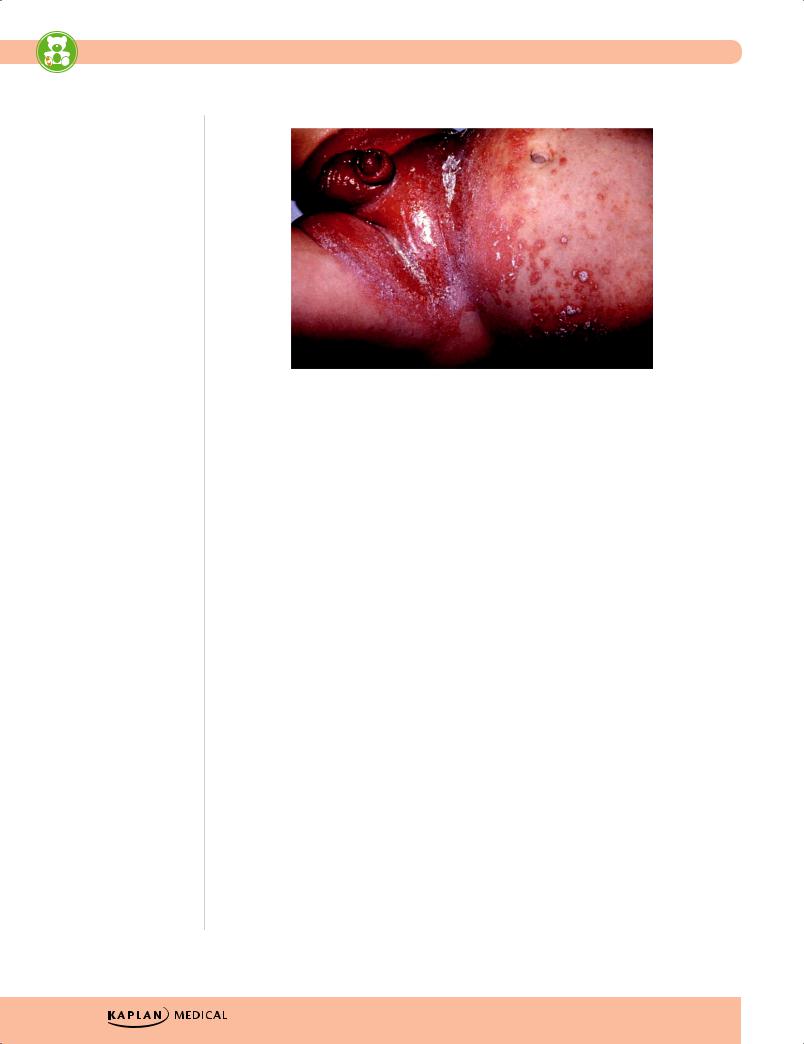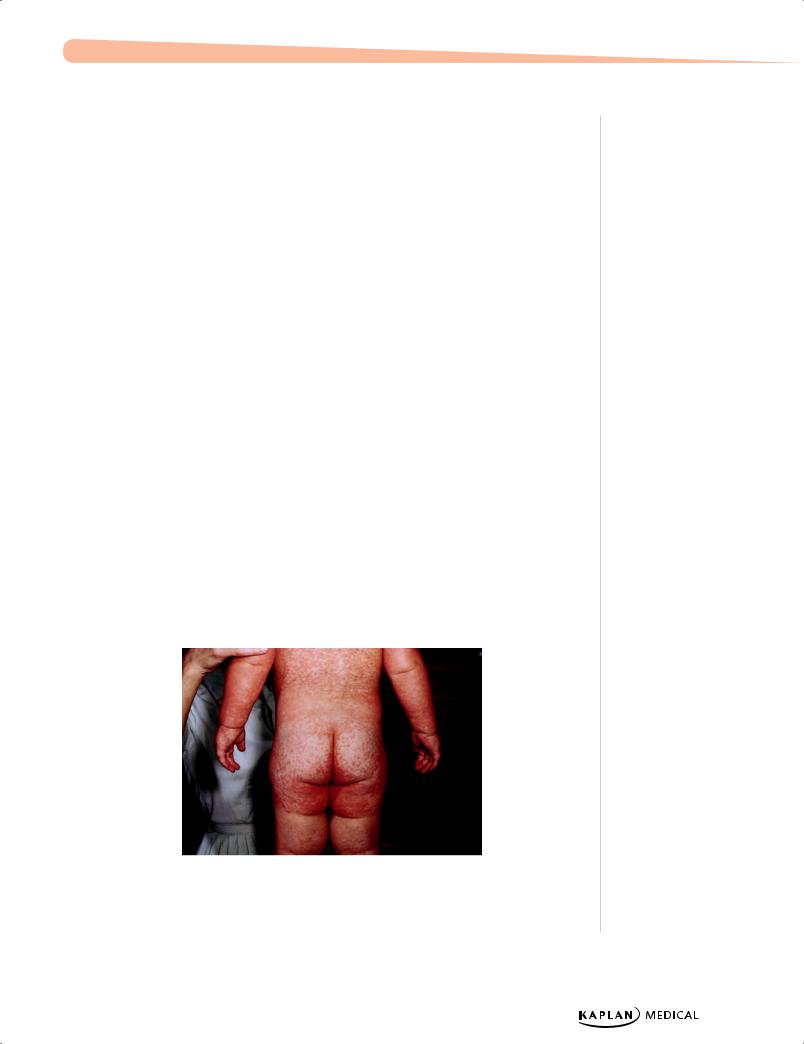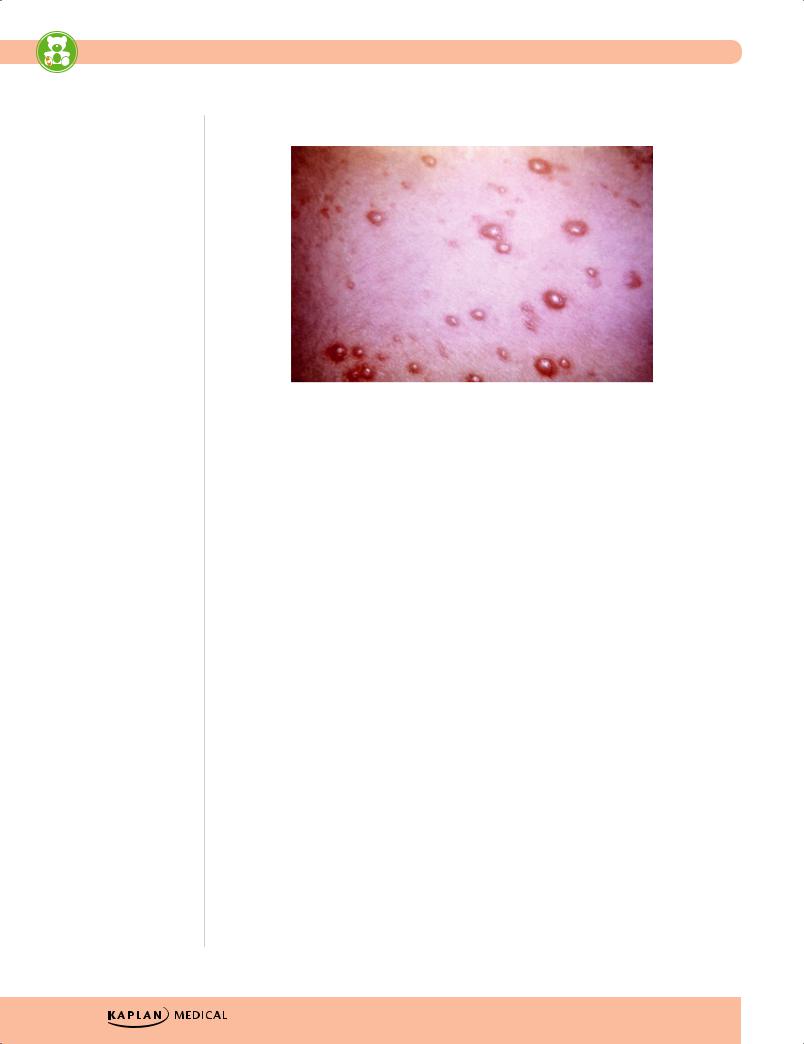
Полезные материалы за все 6 курсов / Учебники, методички, pdf / Kaplan Pediatrics USMLE 2CK 2021
.pdf
USMLE Step 2 CK λ Pediatrics
–Early disease
ºLocal: erythema migrans 3–32 days after bite at site of the bite; target lesion (must be >10 cm in diameter) often called “bulls-eye” rash; fever, headache, and malaise most common symptoms; without treatment, lesion resolves in 1–2 weeks
ºEarly disseminated: secondary lesions, smaller than the primary + constitutional symptoms + lymphadenopathy; uveitis and Bell palsy (may be only finding); carditis (myocarditis, heart block); CNS findings (neuropathy, aseptic meningitis)
–Late disease: arthritis weeks to months later; affecting large joints, more likely to be chronic in adults
•Diagnosis
–No definitive tests
–Primarily clinical and based on history + rash
−Quantitative ELISA test and confirmatory Western blot if the ELISA is positive or equivocal
•Treatment
−Early: doxycycline 14–21 days (if age >8); amoxicillin (if age <8)
−Ceftriaxone with meningitis or carditis (heart block)
−Doxycycline or amoxicillin with Bell palsy
•Prognosis—excellent in children with permanent cure
Clinical Recall
For which of the following patients with Lyme disease is the correct treatment listed?
A.A 10-year-old boy with erythema migrans: doxycycline
B.A 5-year-old girl with meningitis: amoxicillin
C.A 2-year-old boy with erythema migrans: ceftriaxone
D.An 11-year-girl with carditis: doxycycline
E.An 8-year-old boy with Bell palsy: ceftriaxone
Answer: A
ROCKY MOUNTAIN SPOTTED FEVER
A 17-year-old presents to the emergency department with his friends because of fever, headache, and a rose-colored rash that began on his ankles and is spreading. The patient and his friends have been camping in Virginia.
244


USMLE Step 2 CK λ Pediatrics
phil.cdc.gov
Figure 22-1. Diaper Rash Secondary to Candida albicans Infection
•Diaper dermatitis: intertriginous areas of perineum; confluent, papular erythema with satellite lesions
−Diagnosis—skin scrapings; see yeast with KOH prep, but not usually necessary in the presence of clinical findings
−Treatment—topical nystatin; if significant inflammation, add 1% hydrocortisone for 1–2 days
•Catheter-related fungemia can affect any organ; may look like bacterial sepsis
−Diagnosis—buffy coat, catheter tips, urine shows yeast, culture
−Treatment—remove all catheters; amphotericin B is drug of choice
•Chronic mucocutaneous candidiasis—primary defect of T lymphocytes in response to Candida; often when endocrine (diabetes mellitus) and autoimmune disease
Cryptococcus neoformans
•Soil contaminated with bird droppings, or in fruits and vegetables
•Predominant fungal infection in HIV patients; rare in children and immuno competent
•Inhalation of spores; in immunocompromised (mostly in HIV patients) disseminated to brain, meninges, skin, eyes, and skeletal system; forms granulomas
•Pneumonia most common presentation; asymptomatic in many; otherwise, progressive pulmonary disease
•Diagnosis
−Latex agglutination—cryptococcal antigen in serum; most useful for CSF infections
•Treatment
−Oral fluconazole for 3–6 months if immunocompetent and only mild disease
−Amphotericin B + flucytosine if otherwise
−In HIV—lifelong prophylaxis with fluconazole
246


USMLE Step 2 CK λ Pediatrics
Measles
A mother presents to the physician with her adopted daughter, who has just arrived in the United States from a foreign country. The immunization record is not up-to-date. The child has coryza, cough, conjunctivitis, and fever. The mother states that the child also has a rash that began cephalad and spread caudad. On physical examination, a morbilliform rash is seen over the body including the palms. Tiny grayish white dots are seen on the buccal mucosa next to the third molar.
•Rubeola—10-day measles
•RNA Paramyxovirus, very contagious
•Risk factors—Unimmunized entering high school or college
•Incubation—10–12 days before prodrome appears
•Prodrome—3 Cs
−Cough
−Coryza
−Conjunctivitis, then Koplik spots (grayish-white spots on buccal mucosa)
•Final—rash + fever (occur concurrently)
−Rash—macular; starts at head (nape of neck and behind ears) and spreads downward; fades in same manner
•Diagnosis—mainly clinical
•Treatment—supportive, vitamin A (if deficient)
•Complications—otitis media (most common), pneumonia, encephalitis
•Prevention—immunization
Rubella
A 5-year-old child who has delayed immunizations presents with low-grade fever, a pinpoint rash, postoccipital and retroauricular lymphadenopathy, and rose spots on the soft palate.
•German, 3-day measles
•Risk factors/Etiology—Incubation 14–21 days; contagious 2 days before rash and 5–7 days after rash
•Clinical Presentation
−Rash similar to measles, begins on face and spreads to rest of body, lasts approximately 3 days; concurrent with fever
–Retroauricular, posterior, and occipital lymphadenitis are hallmarks.
–Forschheimer spots—affect the soft palate and may appear before onset of the rash
–Polyarthritis (hands) may occur in some patients, especially older females.
•Diagnosis—clinical
•Treatment—supportive
•Prevention—immunization with MMR vaccine
•Complications—congenital rubella syndrome seen if contracted during pregnancy (see Newborn chapter)
248


USMLE Step 2 CK λ Pediatrics
Varicella
phil.cdc.gov
Figure 22-3. ChickenPox is Characterized by Macules, Papules,
Vesicles, and Crusts in Varying Stages of Healing
A 5-year-old child is brought to the emergency center because he has a temperature of 38.9 C (102 F) and is developing a pruritic rash. The rash appears to be in various stages of papules, vesicles, and crusts. It began on his trunk and spread to his extremities.
•Etiology/Risk Factors—due to varicella-zoster virus, a herpes virus
–Incubation 10–21 days
–Transmitted through respiratory secretions
–Remains latent in sensory ganglia after recovery → reactivation in immunosuppressed
•Clinical Presentation—nonspecific symptoms and fever preceding rash
–Pruritic rash in various stages
ºMacules → papules → vesicle → open vesicle → crust
ºLesions can turn hemorrhagic.
ºCrops of lesions at same time
•Clinical diagnosis—no labs
•Treatment
–Supportive in immunocompetent; treat secondary infection
–Consider acyclovir and VZIG in immunocomprised or those at risk for severe disease
•Complications—worse in adolescence (scarring)
–Varicella pneumonia seen in 15–20%
–Other sequelae include Guillain-Barré syndrome, encephalitis, cerebellar ataxia, postherpetic neuralgia, and Ramsay-Hunt syndrome.
–Congenital varicella (see Newborn chapter)
•Prevention—second vaccine dose recommended
250


USMLE Step 2 CK λ Pediatrics
Table 22-3. Common Childhood Infections with Exanthems
|
|
Prodrome |
|
|
Enanthem |
|
|
Exanthem |
|
|
Complications |
|
|
|
|
|
|
|
|
|
|
|
|
|
|
Measles |
|
• Cough |
|
Koplik spots |
|
Macules: hairline, face, |
|
• Otitis media |
||||
|
|
• Coryza |
|
|
|
|
neck → trunk and |
|
• Pneumonia |
|||
|
|
|
|
|
|
extremities |
|
|||||
|
|
• Conjunctivitis |
|
|
|
|
|
• Encephalitis |
||||
|
|
|
|
|
|
|
|
|
||||
|
|
• High fever |
|
|
|
|
|
|
|
• Subacute sclerosing |
||
|
|
|
|
|
|
|
|
|
|
|
panencephalitis |
|
|
|
|
|
|
|
|
|
|
|
|
|
|
Rubella |
|
Mild constitutional |
|
Forschheimer spots |
|
• Similar to measles |
|
Congenital rubella– |
||||
|
|
symptoms |
|
|
|
|
• Posterior cervical & |
|
teratogenic |
|||
|
|
|
|
|
|
|
|
|
|
|
||
|
|
|
|
|
|
|
|
auricular nodes |
|
|
|
|
|
|
|
|
|
|
|
|
|
|
|
|
|
Mumps |
|
• Headache |
|
Glandular swelling |
|
Swollen parotid & |
|
• Encephalitis |
||||
|
|
• Fever |
|
|
|
|
submandibular glands |
|
• Orchitis |
|||
|
|
|
|
|
|
|
|
|
||||
|
|
• Malaise |
|
|
|
|
|
|
|
• Pancreatitis |
||
|
|
• Muscle pain |
|
|
|
|
|
|
|
|
|
|
|
|
|
|
|
|
|
|
|
|
|
|
|
Varicella |
|
• Low-grade fever |
|
None |
|
• Crops of papules, |
|
• Superinfection |
||||
|
|
• Malaise |
|
|
|
|
vesicles |
|
• Zoster |
|||
|
|
|
|
|
|
|
|
|
||||
|
|
• URI symptoms |
|
|
|
|
• Crusts at same time |
|
• Pneumonia |
|||
|
|
|
|
|
|
|
|
|
||||
|
|
|
|
|
|
|
|
• Central to peripheral |
|
• Hepatitis |
||
|
|
|
|
|
|
|
|
|
|
|
||
|
|
|
|
|
|
|
|
|
|
|
• Encephalitis |
|
|
|
|
|
|
|
|
|
|
|
|
• Congenital varicella |
|
|
|
|
|
|
|
|
|
|
|
|
|
|
Fifth Disease |
|
Mild URI symptoms |
|
None |
|
Slapped cheek → trunk |
|
Aplastic anemia |
||||
|
|
|
|
|
|
|
|
→ central clearing-lacey |
|
|
|
|
|
|
|
|
|
|
|
|
|
|
|
|
|
Roseola |
|
• URI symptoms |
|
None |
|
Fever falls rapidly → fine |
|
Febrile seizures |
||||
|
|
• Abrupt onset |
|
|
|
|
macular rash on trunk |
|
|
|
||
|
|
|
|
|
|
and spreads to |
|
|
|
|||
|
|
• High fever then |
|
|
|
|
|
|
|
|||
|
|
|
|
|
|
extremities |
|
|
|
|||
|
|
breaks |
|
|
|
|
|
|
|
|||
|
|
|
|
|
|
|
|
|
|
|
||
|
|
|
|
|
|
|
|
|
|
|
|
|
Scarlet Fever |
|
Sore throat |
|
• Exudative |
|
• Fine maculopapular |
|
• Acute rheumatic fever |
||||
|
|
|
|
|
pharyngitis |
|
rash (feels like sand |
|
• Glomerulonephritis |
|||
|
|
|
|
|
|
|
|
paper, especially in |
|
|||
|
|
|
|
|
• Strawberry tongue |
|
|
|
|
|||
|
|
|
|
|
|
antecubital and |
|
|
|
|||
|
|
|
|
|
|
|
|
|
|
|
||
|
|
|
|
|
|
|
|
inguinal areas) |
|
|
|
|
|
|
|
|
|
|
|
|
• Pastia lines |
|
|
|
|
|
|
|
|
|
|
|
|
|
|
|
|
|
252

